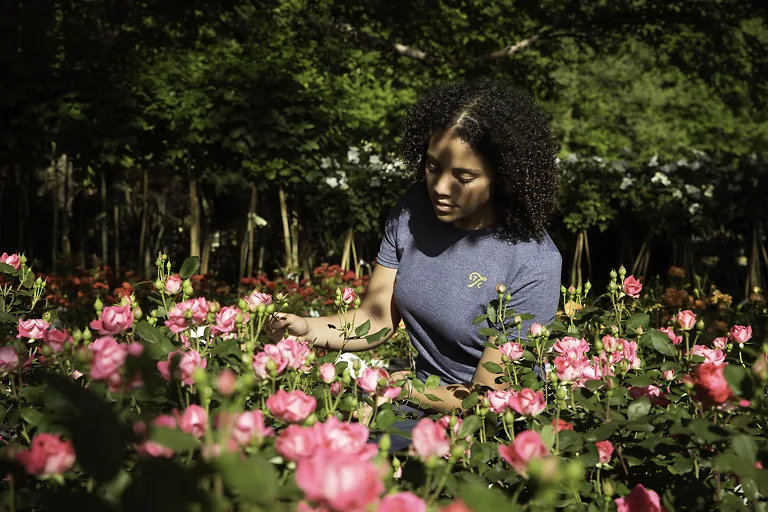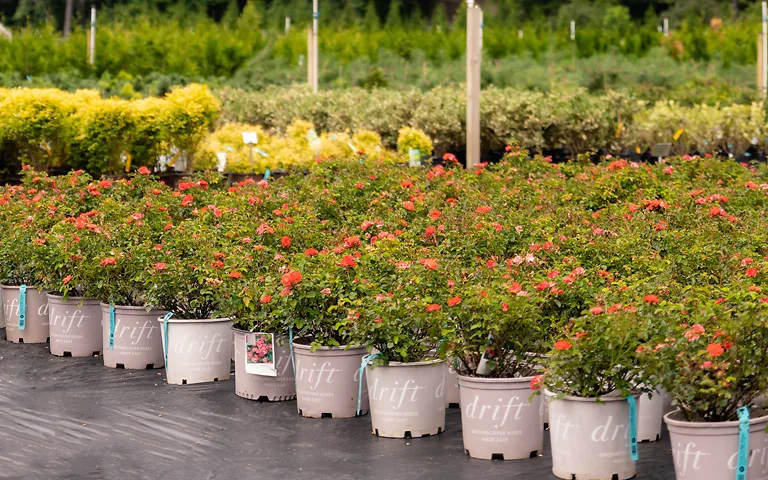
Written by s • Growing a Rose from a Cutting
Growing a new rose from a stem of an older one was the traditional way people passed on loved roses to family and friends. It isn’t hard to do, and works for many – but not all – roses. It is most successful with the beach rose, Rosa rugosa, other wild types of roses, old-fashioned roses, and miniature roses. Some rose varieties are more vigorous when grown ‘on their own roots’ from cuttings, but others won’t be as strong or full of flowers as they are when grafted. It can be hard to predict, and opinions among professionals vary on the relative merits of these two ways of growing roses. It fun to experiment, though!
A rose plant you buy will normally not be grown from a cutting, because nurseries normally grow their roses by budding them onto rootstocks of special varieties, but increasing some are returning to cuttings.
If you want to grow more of a rose you have, cuttings are not difficult, and are usually successful if done correctly. Remember you can’t propagate a rose that is still covered by a patent, but otherwise you can go ahead.
When to Take Rose Cuttings
The best time to take your cuttings will depend on your climate.
If you have colder winters and cool to warm summers, then late spring and early summer is the best time. These are called ‘softwood cuttings’, and generally give the highest success. In a place with hot summers, though, they will be hard to keep alive as they root, and may fail completely. These cuttings can be planted out in the fall or in the following spring.
In areas with hot summers and warmer winters, late summer and fall is best. Those cuttings (called ‘semi-hardwood’) will root over the winter and should be left undisturbed to grow. Water regularly through summer, and give a little half-strength liquid rose food from time to time, until the fall, when they can be planted in their permanent homes.
Preparing the Cuttings
- Use a stem that has recently flowered, and remove a piece about 10 inches long.
- Cut off the tip and dead flower off, just above the first full-sized, healthy leaf. Remove all the remaining leaves.
- Using a very sharp knife and working on a clean surface, make a 45 degree cut just below where a lower leaf was attached. Clean the knife with alcohol when you change to a cutting of a different plant, to avoid spreading virus diseases.
- The final cutting should be 6 to 8 inches long.
- Stand in a jar of water until ready to plant.
- Take more cuttings than you could possibly use, because you won’t have 100% success, although you may get close. They must be taken fresh, prepared within a short time, and planted straight away.
If you want a lot of plants, maybe to make a hedge, then you can prepare a space outdoors to root them. If you just want a few, or live in a colder zone, then rooting them in a pot is easier.
First, How to Do it Outdoors
- Find a suitable place. An area at the foot of a wall or building, facing north or east, is best, as you need shade, at least in the afternoon, but it needs to be well-lit too.
- If you have sandy soil, add about one-third peat moss or composted bark (not bark mulch), mixing it well into the top 8 inches.
- If you have heavy clay soil, the simplest solution is to make a narrow trench and fill it with coarse sand.
- For heavy soil you could also remove some and make a raised bed of a mixture or coarse sand and peat-moss, mixed half and half.
- You can use rooting powder, or not. Without it your success rate will be lower, but still quite good.
- Use a pencil to make holes in the soil about 6 inches apart, in rows, and remember to label them with permanent labels (use an outdoor marking pen) if you are making cuttings from more than one rose.
- Dip the bottom few inches of the cutting into the rooting powder, if you are using it, and insert them into the hole so that about two-thirds of the cutting is buried.
- Firm the soil down around them and water thoroughly.
- Make sure the soil doesn’t dry out – water as needed.
- You will find it easier if you raise the humidity by covering the cuttings.
- This could be with a sheet of plastic, raised clear of the plants with sticks and anchored at the corners
- You can also use a cold frame – a kind of miniature greenhouse like this one.
- These are relatively inexpensive, and you can find plans online to make your own. They are great garden accessories for outdoor propagation of all kinds of things.
How to Do it Indoors
If you just want a few cuttings, then you can do it more easily by rooting in a pot and keeping the pot in an unheated porch, or outdoors in light shade.
- Fill a clean pot with Perlite, or with half perlite and half vermiculite (which doesn’t dry out so fast, but can be too wet if you overdo it). [These are both natural, organic products, just minerals transformed by heat, and totally different from Styrofoam chips. They can be recycled by turning into the ground for extra drainage.] A mixture of half Perlite and half peat-moss is also good. Moisture in a bowl before filling the pot.
- Take softwood cuttings in the same way already described, in early summer.
- Prepare the cuttings and insert several into the Perlite.
- Place three sticks around the edges of the pot. These should be a few inches longer than the cuttings.
- Water thoroughly with a spray, to firm the Perlite and moisten it completely. Let the pot drain.
- Place the whole pot in a large, clear plastic bag and tie at the top, or if you don’t have a big enough bag, slide a large one over from the top, taping it to create a humid environment.
- Place in bright light, out of direct sun.
- Check from time to time that the mix hasn’t become dry, but don’t water unnecessarily.
- Once you see roots coming out of the drainage holes, or lots of new shoots sprouting, you can carefully tip the cuttings out, and transfer the rooted ones into pots in regular potting soil. Only plant in the ground when there are abundant roots, preferably waiting until fall.
- Don’t keep potted roses indoors for winter, as this will interfere with their natural growth cycle and need for winter cold.
- The plants will probably bloom a little the next summer.







